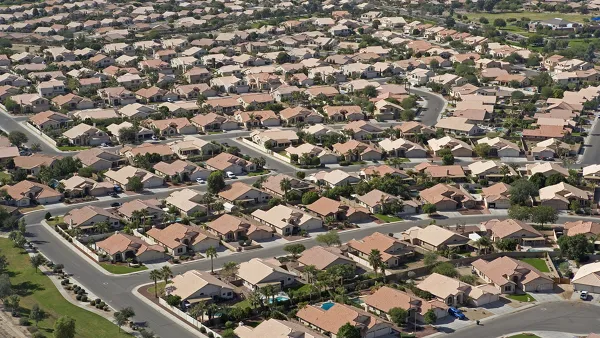There is still time to reverse the environmental outcomes of American suburbs. Researchers in Los Angeles, considered by many to be the poster child for U.S. sprawl, have been at work on the problem for years.

“Currently, the sprawling outer areas of US cities are environmentally unsustainable and a wasteful use of land,” begins a provocative article by Dana Cuff, a professor of architecture and urban design at the University of California, Los Angeles (UCLA).
Among the complaints about the U.S. suburban proclivity, Cuff lists “ social stratification and an unequal distribution of wealth and opportunity,” greenhouse gas emissions, long commute times, congestion, high infrastructure costs, and high housing costs.
“But even US suburbs are not beyond redemption,” writes Cuff to switch to a more optimistic note about the potential for suburban redemption.
Promoting ideas explored by over a decade of work at cityLAB, a urban-design research center at UCLA, to solve the problems of sprawl in Southern California. Among the prescriptions offered here are a call to change the rules about what can be built and where (“Three-quarters of residential areas in US cities are designated as ‘single family’, meaning that just one house can be built on each plot”) as well as parking requirements.
Cuff also argues for the use of state law to preempt local zoning regulations, writing: “My research indicates that well-designed state laws on land use can boost public benefits while allowing local jurisdictions to adjust projects to local needs. For example, cities with relatively large houses or small plots could customize laws to allow secondary units to be carved out of existing homes.”
The source article, linked below, concludes with a series of questions recommended by Cuff to begin to address the poor environmental outcomes of suburbia.
FULL STORY: Suburbs are a climate disaster, but they can be redeemed

National Parks Layoffs Will Cause Communities to Lose Billions
Thousands of essential park workers were laid off this week, just before the busy spring break season.

Retro-silient?: America’s First “Eco-burb,” The Woodlands Turns 50
A master-planned community north of Houston offers lessons on green infrastructure and resilient design, but falls short of its founder’s lofty affordability and walkability goals.

Delivering for America Plan Will Downgrade Mail Service in at Least 49.5 Percent of Zip Codes
Republican and Democrat lawmakers criticize the plan for its disproportionate negative impact on rural communities.

Test News Post 1
This is a summary

Test News Headline 46
Test for the image on the front page.

Balancing Bombs and Butterflies: How the National Guard Protects a Rare Species
The National Guard at Fort Indiantown Gap uses GIS technology and land management strategies to balance military training with conservation efforts, ensuring the survival of the rare eastern regal fritillary butterfly.
Urban Design for Planners 1: Software Tools
This six-course series explores essential urban design concepts using open source software and equips planners with the tools they need to participate fully in the urban design process.
Planning for Universal Design
Learn the tools for implementing Universal Design in planning regulations.
EMC Planning Group, Inc.
Planetizen
Planetizen
Mpact (formerly Rail~Volution)
Great Falls Development Authority, Inc.
HUDs Office of Policy Development and Research
NYU Wagner Graduate School of Public Service





























